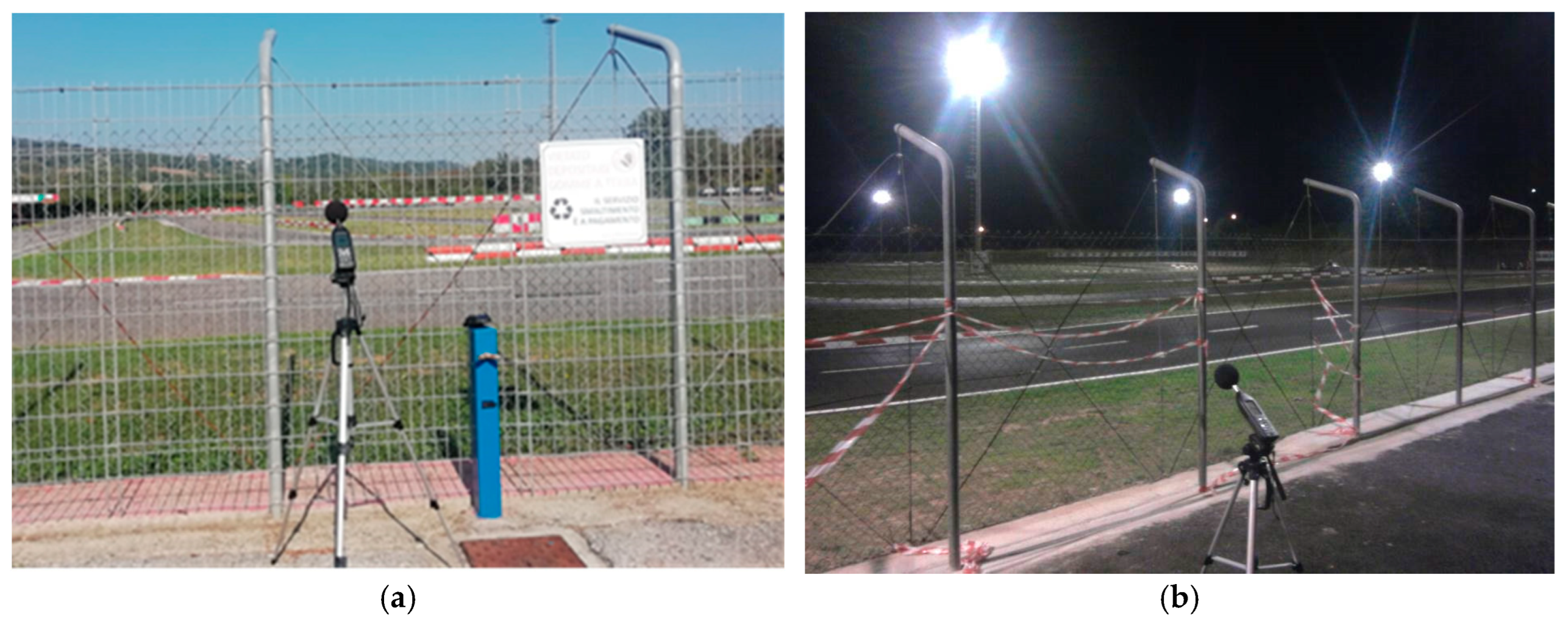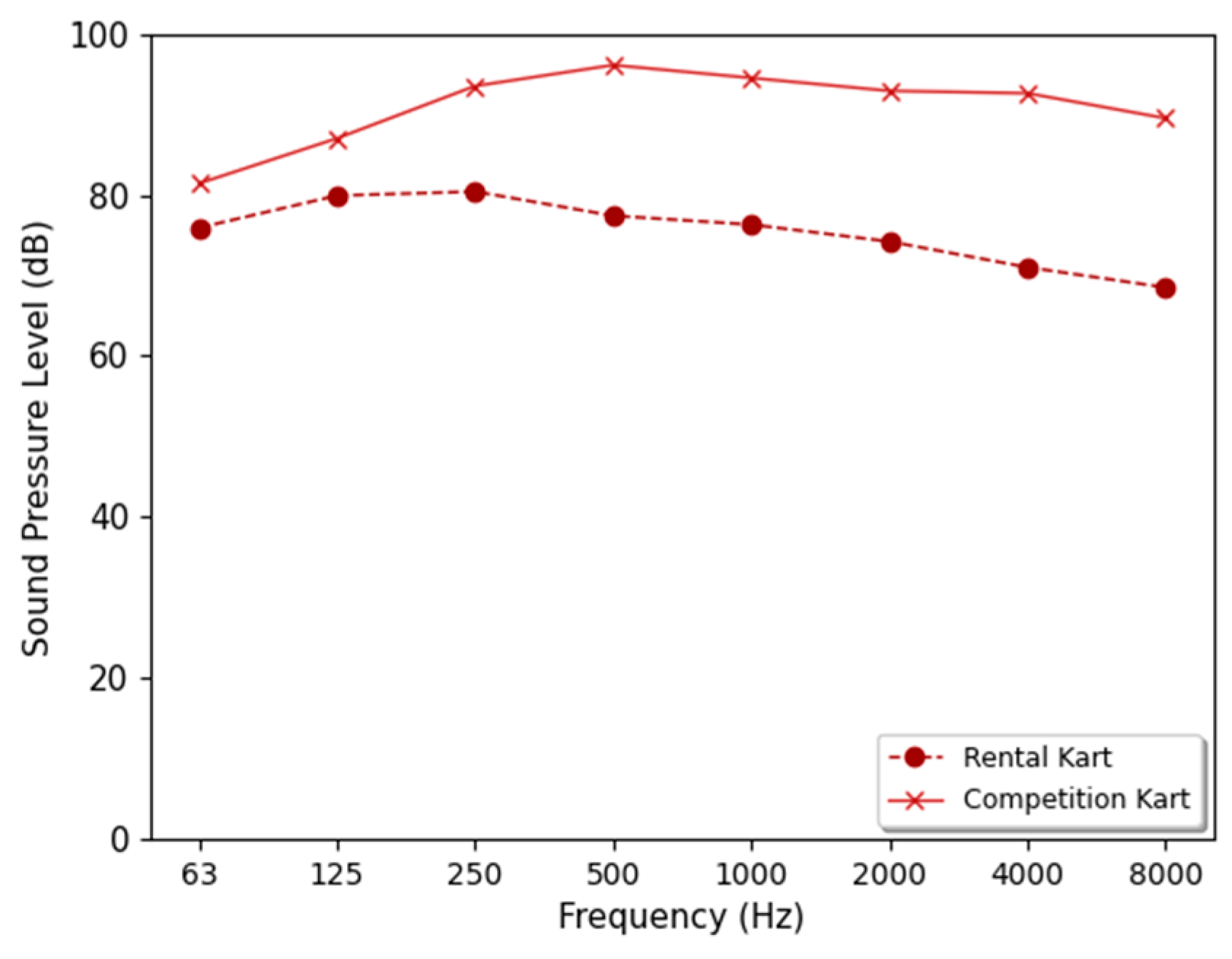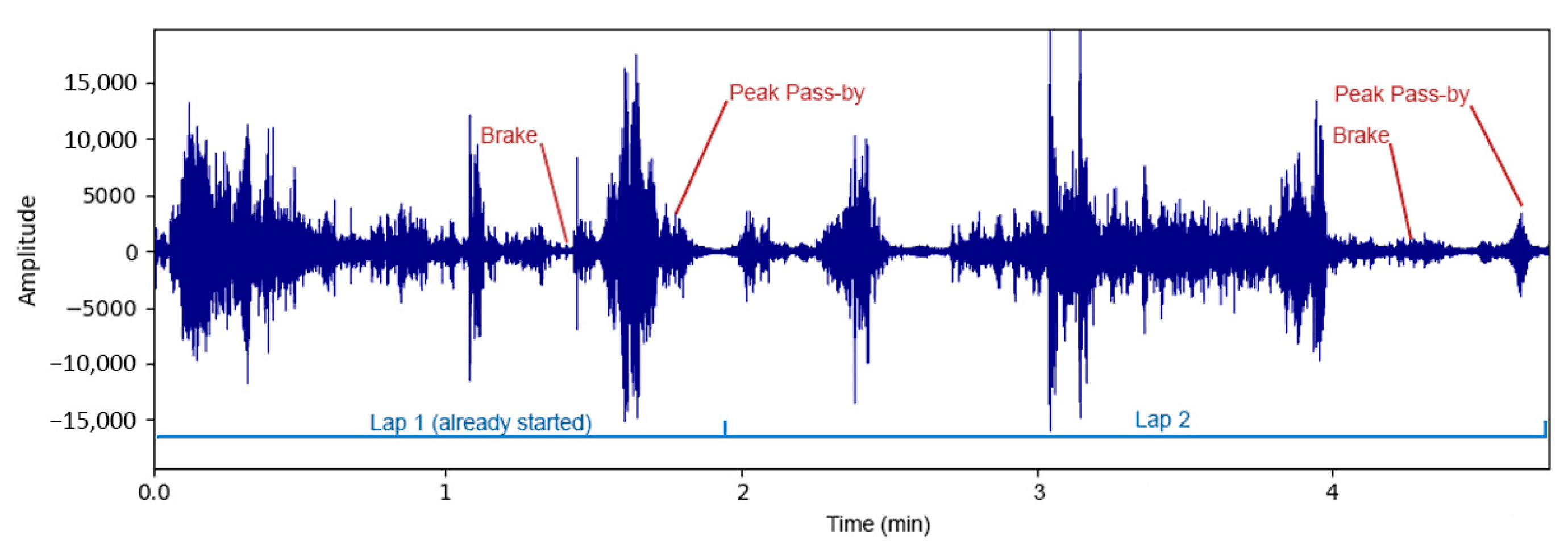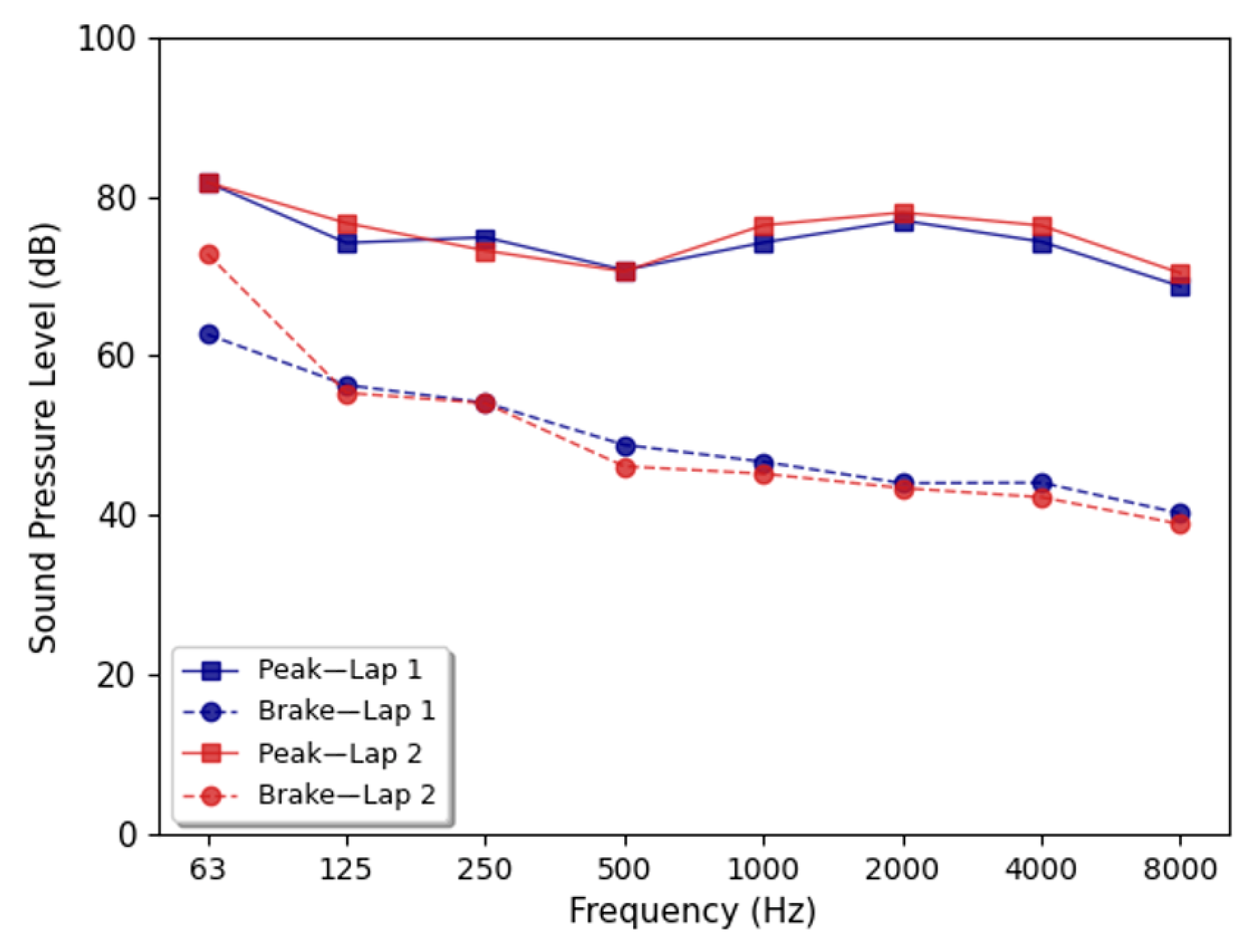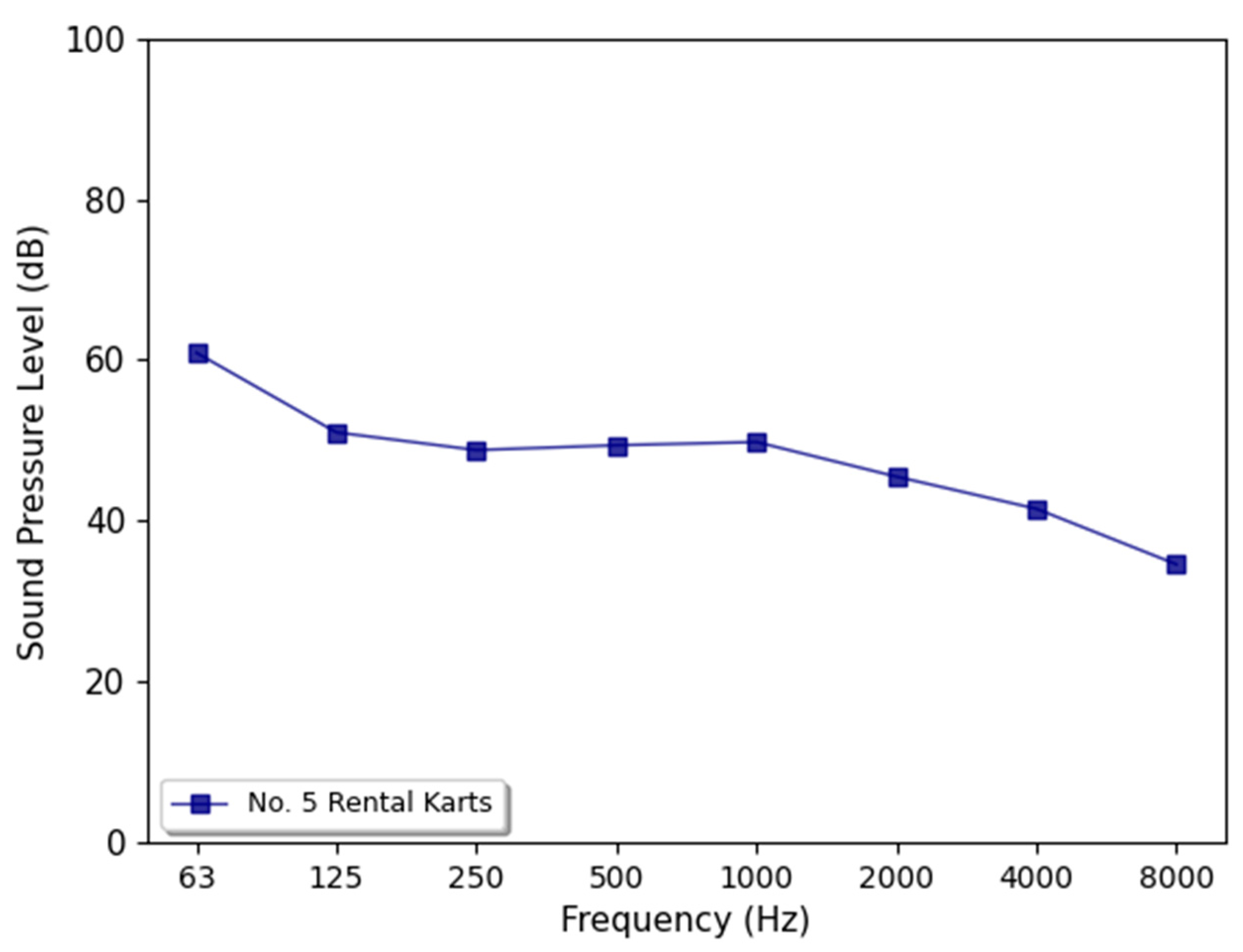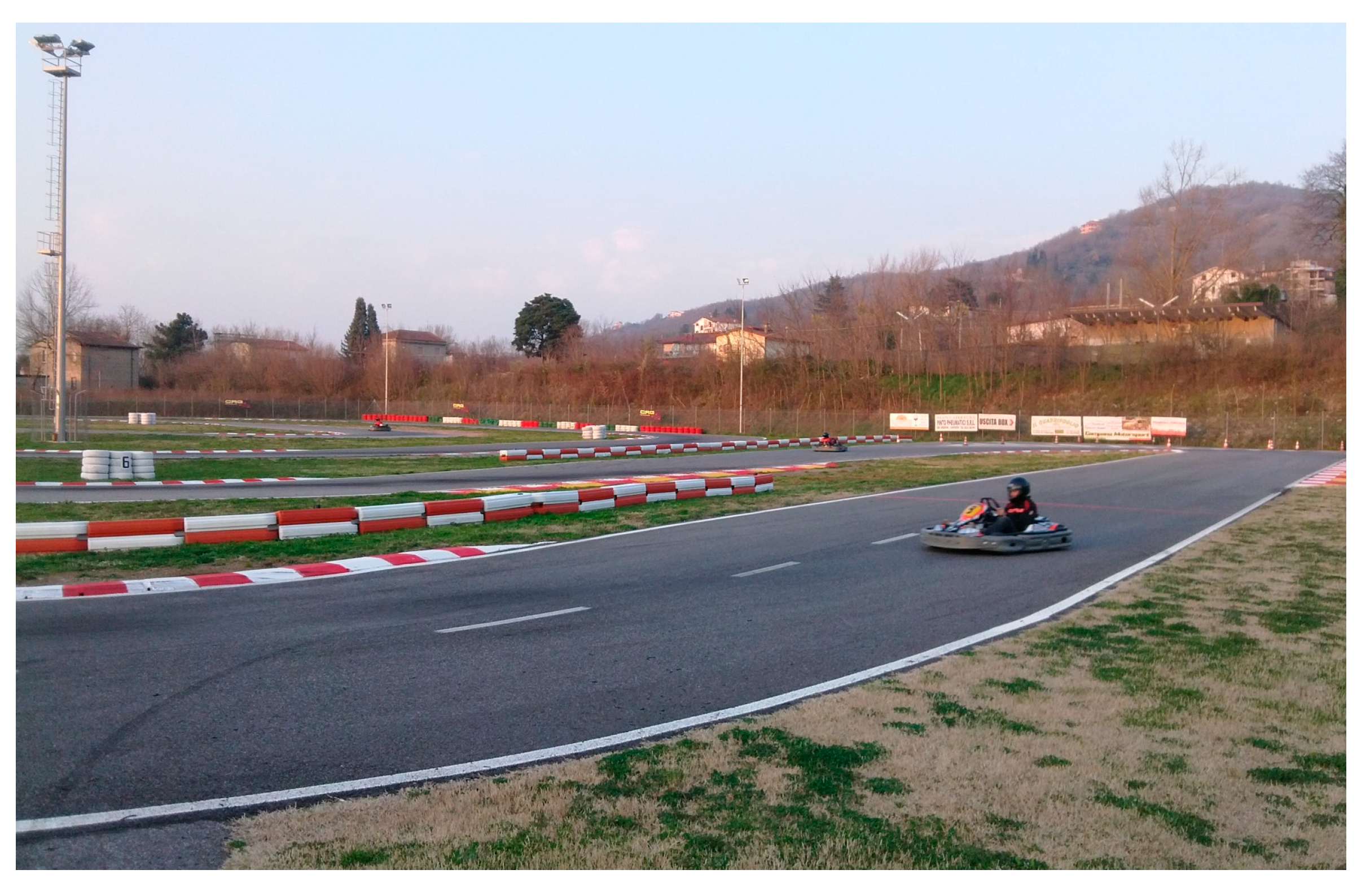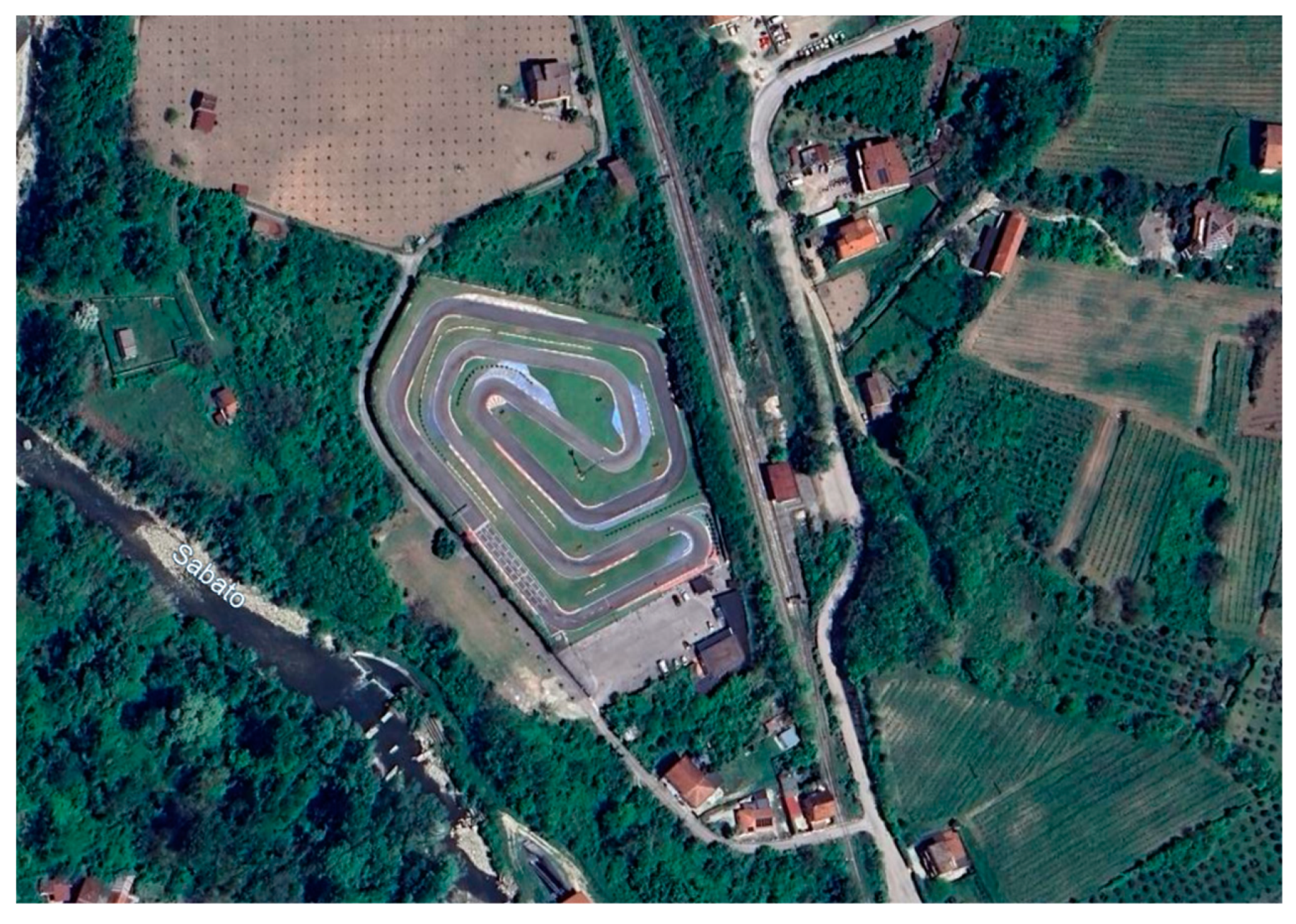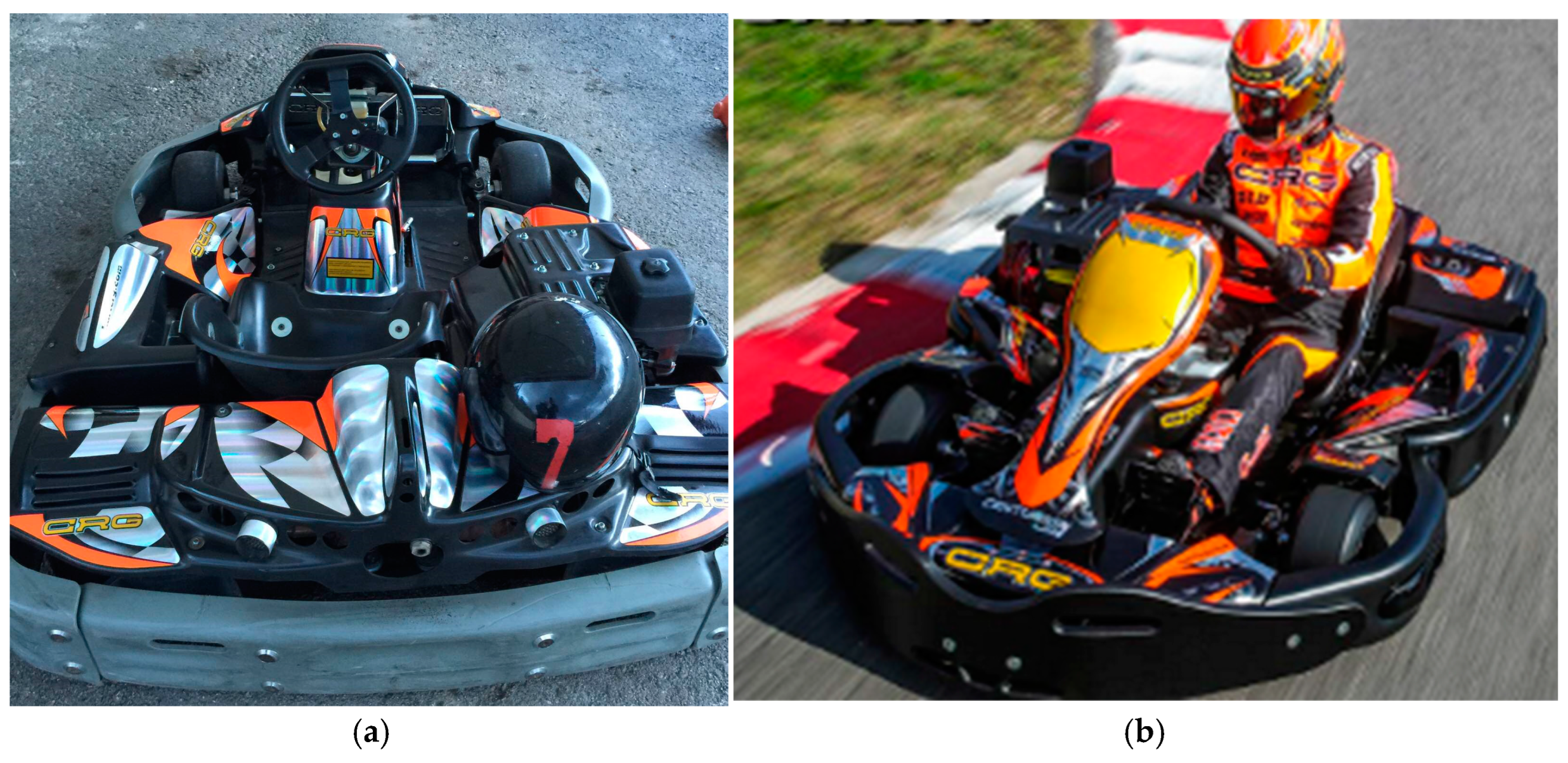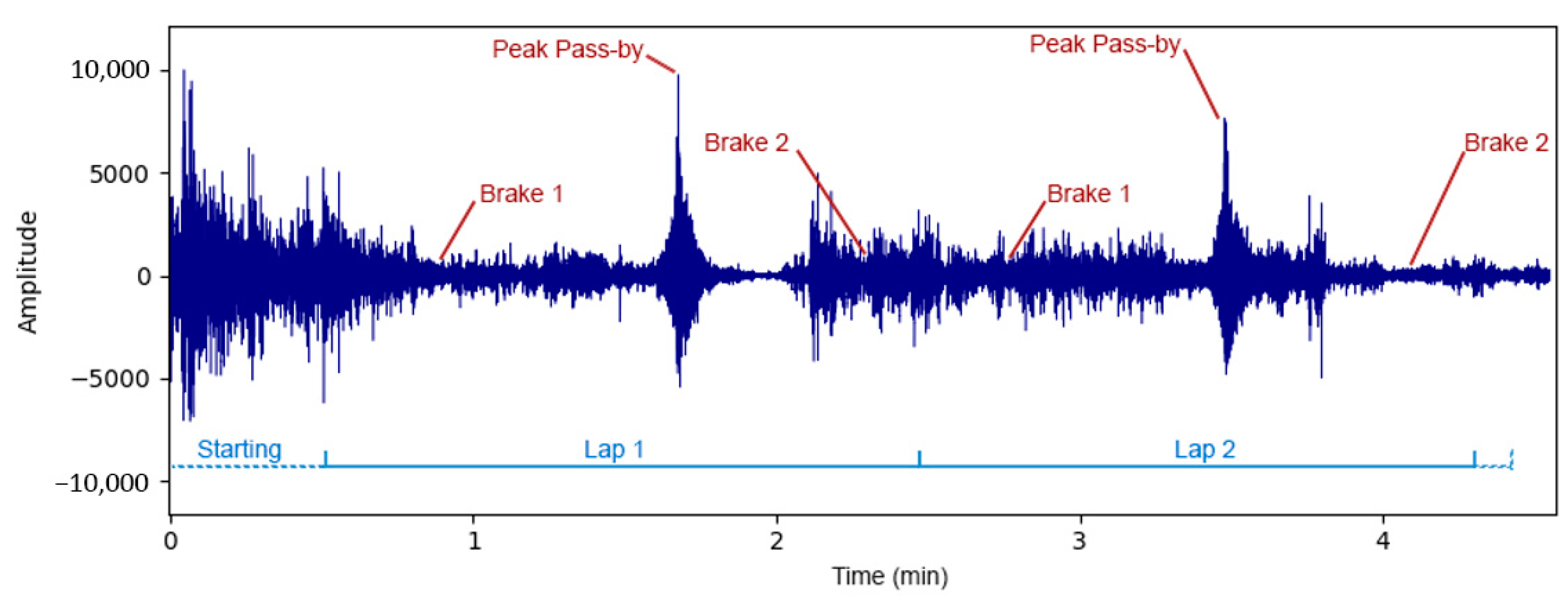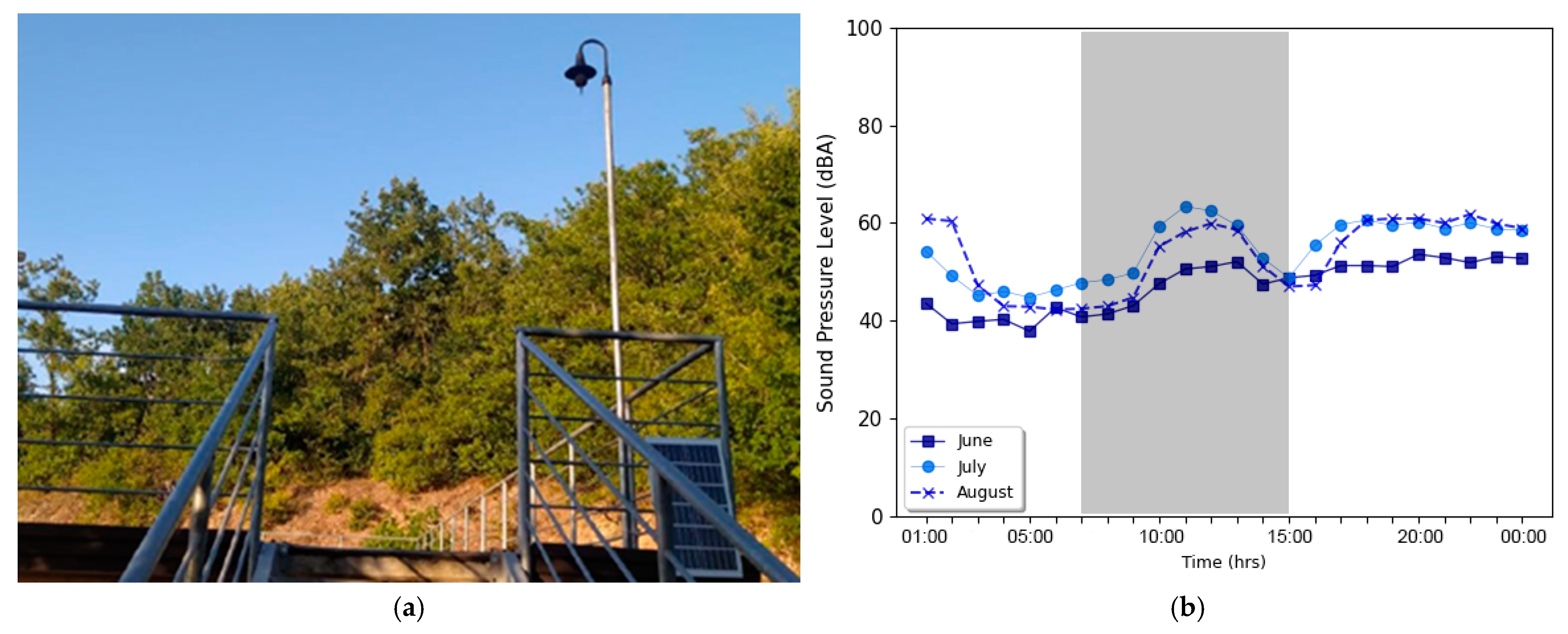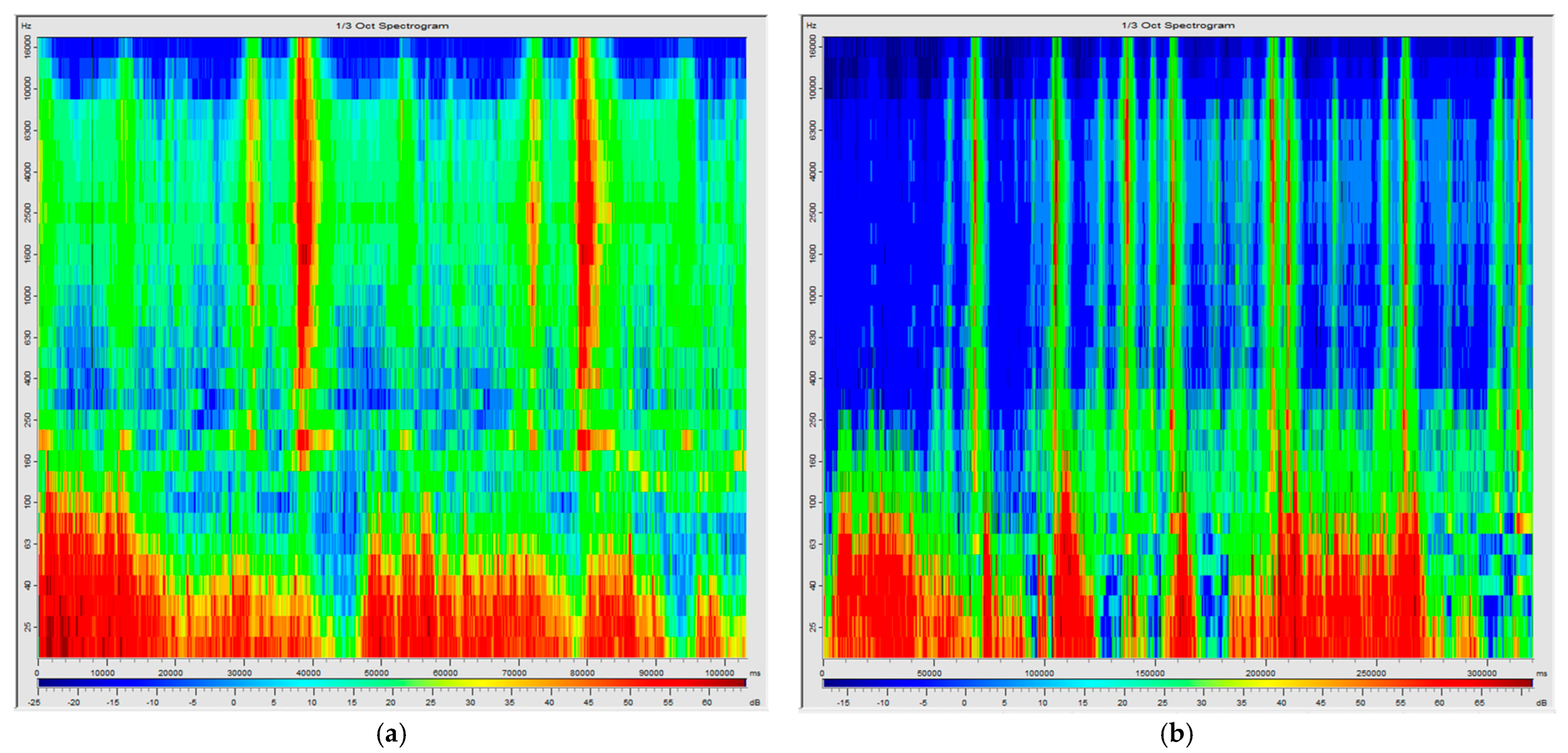1. Introduction
Kart racing often generates significant nuisance that can disturb sensitive receptors, especially when they are located in urban and suburban areas and lack adequate sound barriers at their perimeter. Many kart dromes operate in the evening or at night, raising potential concerns about sleep disturbance and residential comfort. The noise emission from sportive cars is not regulated in detail by the local authority, causing some conflicts between the commercial activity of the karts and private citizens.
Although the noise emission from sportive cars exceeds the regulatory noise limits established for passenger road vehicles, the loud engine sounds are integral to the racing experience, enhancing the excitement for drivers and spectators. However, these noise levels pose potential risks related to hearing damage that can even lead to permanent hearing loss. On the other hand, kart manufacturers could establish a certain limit of noise emission from the engine such that the attendees do not encounter excessive exposure to high noise levels.
Previous research studies have investigated noise emissions from various sportive vehicles, such as motorbikes competing in the Canadian Superbike championship, where a microphone fixed in a specific location reported the analysis of the events [
1]. The same type of analysis has been performed for the estimation of noise levels in racing motorbikes [
2]. Other research studies state the way to calculate noise levels at the side of the circuit for experimental measurements [
3]. Computational methods have also been developed to detect a single vehicle’s contribution from the general background noise level in an urban context [
4,
5]. These findings underscore the need for environmental noise assessments to inform local authorities in establishing effective contour levels for regulations that can be elaborated in noise maps for daytime and nighttime periods so that individuals remain protected and safeguarded.
This paper evaluates noise emissions from rental and competition karts through short- and long-term acoustic measurements in order to highlight the characteristics of pass-by peaks as well as strong breaks at curves. For a complete assessment, the measured on-site values were compared with the values obtained from laboratory conditions for both rental and competition karts. These values were plotted to understand the impact of this type of nuisance on nearby receptors that, in many cases, are in conflict with commercial activities during a full operation, which occurs in summer.
The kart drome subject in this study is located in a rural environment, at an altitude of 350–400 m from the mean sea level, in southern Italy. The area is also occupied by other commercial activities, such as vehicle repair garages. There is also a local railway at a 40 m distance from the kart drome, where a maximum number of 10 train passings per day takes place.
2. Materials and Methods
The kart drome operates only during the summer season, from mid-June to late August, between 18:00 and 00:00. Usually, rental karts dominate the first 60–90 min, followed by competition kart sessions that take place in the same circuit. A map of the kart drome is given in
Figure 1. In the proximity of the circuit, there are also sensitive receptors, among which the closest one is approximately 80 m away.
There is a net distinction between hiring/rental and competition karts in terms of sound intensity, and both are herein studied. Specifically, the rental karts are characterized by a fuel engine type 270 cc Honda GX, composed of only one gear, and that can achieve ranging speeds of 65–80 km/h. If the weight is lighter and they are better optimized, the rental karts can even reach a speed of 95 km/h. They are characterized by a low noise emission due to the installation of a silencer situated on the muffler [
6,
7].
Competition karts are rather more powerful and can reach significantly higher speeds due to optimized designs, lightweight frames, and high-performance engines that can be 125–250 cc, with a capacity of achieving speeds of 120–170 km/h if mono-gear, while super-karts with a 250 cc engine can also reach 220 km/h with multiple gears. Competition karts can perform 15 to over 50 horsepower.
Figure 2 shows the two types of karts in comparison.
2.1. Laboratory Measurements of Rental and Competition Karts
Noise emissions from rental and competition karts were measured in an accredited laboratory in accordance with ISO 5130 [
8] regarding the testing methods for sound levels from vehicles. The equipment consisted of a Class 1 sound level meter, type 01dB (MCE-212), placed in different locations at 4 m distance from a hypothetical center of a sphere, as suggested by the standard requirements, to cover the sound emission with a hemispherical spreading towards the sides and the zenith.
The technical reports show that rental karts emit a sound pressure level of LEP 81 dB(A) at high RPMs when measured at a standard distance, while competition karts with a two-stroke engine emit a sound pressure level of LEP 100 dB(A) at high RPMs and under similar conditions.
The characteristics of the spectrum are described as follows:
Low-frequency content (20–250 Hz) is dominated by the mechanical vibration and by the lower harmonics of the engine’s rotation [
9].
Mid-frequency content (250–1000 Hz) is dominated by the noise from the combustion, identified as the typical buzz [
10].
High-frequency content (1000–5000 Hz) is characterized by the noise from the intake and exhaust systems, in combination with the gears that generate a high-pitched sound [
11].
2.2. In Situ Measurements of Rental and Competition Karts
The acoustic measurements were carried out by using a class 1 sound level meter, type LARSON & DAVIS (LD-824, serial number 0418, Depew, NY, USA ). The microphone was installed at a 1.6 m height from the ground, and the locations were selected to be in two specific places:
The location of the microphone at the edge of the track, which was at a 10 m distance from the center of the lane, allowed for the detection of the noise emitted by karts in transit. Based on kart pass-by, the audio recordings could primarily capture the engine noise, which varied based on speed and load conditions, followed by other types of noise typical of a competition vehicle, like braking noise in the form of squealing and grinding sounds, especially under high braking forces, and tire noise during acceleration.
Figure 3.
Equipment installed at the border of the racing circuit during the evening (a) and nighttime (b).
Figure 3.
Equipment installed at the border of the racing circuit during the evening (a) and nighttime (b).
The second location where the microphone was placed was along the main road, and the third microphone location was in a domestic property, which was the closest sensitive receptor to the racing circuit.
3. Results of Surveys
3.1. Measurements from the Laboratory Tests
As anticipated in the previous section, the rental karts have a sound emission level of L
EP 81 dB(A), which is almost 20 dB less than the competition karts, whose sound level was found to be equal to L
EP 100 dB(A), as shown in
Figure 4.
Specifically,
Figure 4 shows that there is only a difference of 3–4 dB between the rental and competition karts at low frequencies, while a difference of almost 20 dB is found for the mid-high octaves. These sound spectra were used to calculate the sound spreading from the kart drome to the surrounding areas with a computational model, which will be explained in the next section.
Figure 4.
Sound pressure level spectra comparison related to hiring/rental and competition/racing karts.
Figure 4.
Sound pressure level spectra comparison related to hiring/rental and competition/racing karts.
3.2. Measurements Gathered at the Side of the Circuit
3.2.1. Analysis of the Sound Emission from Competition Karts
The results gathered from the measuring point at the side of the circuit are present in
Figure 5,
Figure 6,
Figure 7,
Figure 8,
Figure 9 and
Figure 10. During the surveys, the outdoor hygrometric conditions were taken into consideration: the temperature was about 25 °C, the relative humidity was 50%, and the wind conditions were deemed stationary [
12]. The first survey lasted around 5 min, during which a competition kart completed two laps, as indicated in
Figure 5, where the soundwave is plotted as a function of time.
Figure 5 illustrates the kart’s starting point and highlights the acoustic events during each lap with amplitude variations influenced by the circuit’s design. Notably, the duration of the two laps shows slight differences due to the vehicle’s speed, which reached its maximum level during the second lap.
Figure 6 shows the spectra relating to the main prominent events, where the consistency is described as follows:
The spectra related to the maximum levels of the competition kart pass-by during acceleration along a straight line.
The spectra related to the maximum levels of the first brake at a curve.
The spectra related to the maximum levels of the second brake at another curve.
Figure 6 shows that the noise levels emitted by a competition kart in motion are lower than those measured under laboratory conditions. This discrepancy suggests that factors such as circuit design and driving dynamics significantly influence noise emission to the surrounding environment. In contrast, laboratory measurements reflect maximum engine RPMs, which may not be consistently achieved during on-track operation.
Figure 6.
Sound pressure level spectra related to a competition kart running for 2 laps in the circuit: the blue color represents lap No. 1, and the red color represents lap No. 2.
Figure 6.
Sound pressure level spectra related to a competition kart running for 2 laps in the circuit: the blue color represents lap No. 1, and the red color represents lap No. 2.
3.2.2. Analysis of the Sound Emission from Rental Karts
A similar analysis was conducted for the rental karts. The measurement duration was approximately the same, around 5 min, as lap No. 1 had already commenced. In this recording track, the amplitude peaks of the soundwave do not align with the pass-by peaks due to extraneous noise from amateurs attending the events, which affected the survey. However, the spectra corresponding to strong braking moments and kart pass-by were clean and undisturbed.
Figure 7 illustrates that the amplitude levels of the peaks associated with the rental kart pass-by events are lower than those of competition karts. Additionally, fewer events of strong braking were observed, attributable to a reduced speed of the vehicle.
Figure 7.
Noise levels from the rental karts recorded at the side of the circuit for almost 5 min.
Figure 7.
Noise levels from the rental karts recorded at the side of the circuit for almost 5 min.
Figure 8 shows the spectra corresponding to the main prominent events, described as follows:
The spectra corresponding to the maximum noise levels during a rental kart pass-by by at full acceleration along a straight line.
The spectra corresponding to the maximum levels during braking at a curve.
Figure 8 shows that the noise levels emitted by a rental kart while on the circuit are comparable to those measured under laboratory conditions, with the exception of 500 Hz, where the on-site values were 3 dB lower than the laboratory results. In comparison to competition karts, rental karts exhibit a higher low-frequency content [
13], which corresponds to a range of spectrum that travels longer distances and can negatively impact the surrounding area. However, the agreement between the laboratory and site measurements validates that the predictions of noise from sporting vehicles based on local regulations [
14] remain reliable, regardless of which set of data is used.
Figure 8.
Sound pressure level spectra related to a rental kart running for 2 laps in the circuit: the blue color represents lap No. 1, and the red color represents lap No. 2.
Figure 8.
Sound pressure level spectra related to a rental kart running for 2 laps in the circuit: the blue color represents lap No. 1, and the red color represents lap No. 2.
The noise levels based on local regulations [
14] were assessed alongside the analysis of individual events. Specifically, the overall values measured at the side of the circuit were expressed in terms of the continuous equivalent sound pressure level (Leq). For this case, measurements were executed by adding a rental kart at a time to the race, allowing for the determination of each kart’s contribution, as summarized in
Table 1. The overall survey lasted for 15 min.
Table 1 shows that the worst-case scenario occurs when multiple karts are on the circuit, as is typically the case during a race: the greater the number of rental karts, the higher the noise levels.
To understand the noise emission at each octave,
Figure 9 represents the frequency plot of the sound level emitted by five rental karts measured at the racing border line. The spectrum highlights that a uniform noise level is recorded across the frequency bands between 63 Hz and 500 Hz, equal to 66 dB. This value is lower than the previously discussed levels, which is due to the longer duration of the survey. However, the noise levels drop significantly above 1 kHz, indicating that the engine noise is the primary factor contributing to the overall level. This is more impactful than the friction between the wheels and the asphalt. The main contributions due to the noise level from the engine are during the acceleration and braking driving phases.
Figure 9.
Frequency spectrum emitted by 5 rental karts measured at the side of the circuit over a 15 min survey.
Figure 9.
Frequency spectrum emitted by 5 rental karts measured at the side of the circuit over a 15 min survey.
3.3. Measurements Carried Out at the Closest Sensitive Receptor (i.e., Domestic Residence)
The evaluation of noise emissions from rental kart racing was conducted at a domestic property, considered the closest sensitive receptor, located approximately 80 m from the external perimeter of the runway.
The microphone registered the equivalent sound pressure levels (Leq) for a period of 1 h, as summarized in
Table 2. The microphone was placed in a bedroom on the first floor of a two-story building, with the window open. The conditions during this survey were as follows:
Table 2 shows that the difference in terms of noise levels between the pass-by of only one rental kart and five rental karts is 5 dB. An increase in the noise level from 47 to 52 dBA is considered just perceivable, with limited impact on sleep disturbance, especially since the measurements were conducted with the window open, as required by the regulations.
Figure 10 shows the spectrum of the pass-by of five rental karts recorded within the domestic building. Specifically, it indicates that the maximum levels are found between 63 Hz and 125 Hz, ranging from 50 to 60 dB, while levels at high frequencies are significantly reduced, mainly due to the effect of air attenuation.
Figure 10.
Frequency spectrum emitted by 5 rental karts measured in the sensitive receptor over a 15 min survey.
Figure 10.
Frequency spectrum emitted by 5 rental karts measured in the sensitive receptor over a 15 min survey.
3.4. Additional Long-Term Survey in the Center of the Kart Drome
Additional noise levels were recorded by a microphone placed in a fixed position within the kart drome, as shown in
Figure 11a. The measurement covered a complete week for each of the months of June, July, and August. The Leq values were logged for 1 h and averaged over 7 days, each recording the racing of rental karts. In particular, the selected weeks were 20–27 June, 9–16 July, and 2–9 August.
In
Figure 11b, the central hours of the day were excluded since they were related to extraneous activities within and around the circuit (highlighted in grey). Overall, the graph indicates an increase in hourly noise levels as activity increases during the summer and becomes more popular. Particular attention should be paid to the nighttime period when the noise levels remain consistent around Leq 50 dBA in June and even Leq 60 dBA in July–August. These values remain consistent past midnight, up to 02:00 when the kart drome finishes the races of the day.
4. Discussion on Noise Emission from a Competition Kart and a Rental Kart
To better understand the difference in noise levels emitted by a competition kart and a rental kart, the analysis considers the acoustic measurements carried out at the edge of the circuit. It should be noted that the same driver operated both types of karts, minimizing any difference in piloting performance. The microphone was located at the side of the circuit, where the average speed is about 60 km/h.
It was demonstrated that the noise levels from competition karts are higher than those emitted by rental ones. This difference is due to the distinct types of mufflers installed on the karts.
In terms of LAeq, the pass-by of a competition and a rental kart are summarized in
Table 3, highlighting a difference of 6 dB.
The same results can be expressed with a spectrogram, as summarized in
Figure 12, where the graph related to the competition kart indicates noise levels around 60–68 dB, especially at high frequencies, while the graph related to the rental kart indicates high noise levels mainly centered at low frequencies.
5. Assessment with a Numerical Model
A numerical model of the measured data was developed with CadnaA 2024 software [
15], from which four plots were created based on the input values discussed in previous sections:
Plot A: A total of 10 competition karts based on laboratory measurements.
Plot B: A total of 10 competition karts based on site measurements.
Plot C: A total of 10 rental karts based on laboratory measurements.
Plot D: A total of 10 rental karts based on site measurements.
The acoustic simulations were carried out based on the characteristics of the circuit lane (i.e., width, number of vehicles) specific to this context. The environment was faithfully reproduced in the model by specifying building heights, assigning an absorption coefficient of 0 to reflective surfaces, such as parking spaces and pavement, and a value of 1 to absorbing surfaces, such as grass.
Figure 13 shows the specific scenarios mentioned earlier, considering a total of 10 karts (of the same type) running on the circuit, reflecting the real situation without mixing kart types, as shown in
Figure 14. The spectra used as input data are related to the peak pass-by levels, while the grids in
Figure 13 represent a height of 3 m.
Figure 13a shows that the noise levels at the nearest sensitive receptors, with the laboratory values for 10 competition karts, are around L
EP 65–70 dBA, which are reduced to L
EP 55 dBA when the site-measured values for 10 competition karts are plotted, as shown in
Figure 13b. The difference of about 10–15 dB is very significant and easily noticeable. When the values for rental karts are plotted, there is a negligible difference between the laboratory and site-measured values, as shown in
Figure 13c,d.
Figure 13.
Grid values of 10 karts singularly plotted: laboratory values related to competition karts (a), site values related to competition karts (b), laboratory values related to rental karts (c), and site values related to rental karts (d).
Figure 13.
Grid values of 10 karts singularly plotted: laboratory values related to competition karts (a), site values related to competition karts (b), laboratory values related to rental karts (c), and site values related to rental karts (d).
Figure 14.
View of a typical kart racing where multiple vehicles are competing.
Figure 14.
View of a typical kart racing where multiple vehicles are competing.
6. Discussion and Conclusions
Environmental assessments of kart dromes are not commonly conducted due to the sporadic presence of circuits in operation, limited to a few cities. This type of hobby primarily engages young people, teenagers, and lovers of this sport, which is more accessible than Formula 1 racing. However, the noise generated by racing during nighttime poses a nuisance to nearby residential properties, making it difficult for residents to sleep [
16]. Disputes between commercial activities and private individuals are common, often due to a lack of clear regulations regarding kart dromes, as they cannot be considered equivalent to Formula 1 racing venues for obvious reasons [
17].
This paper analyses the noise generated from both competition and rental karts at different distances from the circuit center and over different durations. It has been demonstrated that rental karts are less noisy than competition karts, as their engines and mufflers are intentionally designed to operate at lower performance levels in terms of speed [
18]. In contrast, competition karts can reach noise levels of LAeq 75–80 dB when running at maximum speed in a straight line of the circuit. This becomes a concern, especially because races are often held during the evening and nighttime when the noise thresholds set by the local authority are lower than during the day. However, businesses that attract users only during this short period of the year cannot be limited.
The analysis presented here has several limitations that prevent it from being extended to all other kart dromes, which are discussed below:
One limitation is the topography of the site. In this particular case, the site is flat and at a uniform height above sea level. However, other kart dromes may be located in valleys, where mountains limit noise propagation in all directions, or on the top of a hill, where exposure to noise is direct and no natural shadow zones are present. Therefore, the measured and simulated results presented in this paper are only applicable to similar terrain configurations. For other geographic contours, it is important to consider the height difference between the noise source and the receiver.
Another limitation of this study is the type of source, as it can vary between different kart dromes. The speed and power of the engines can differ significantly between the two types of karts analyzed here. Therefore, a potential noise mitigation solution would involve replacing some components of the vehicle with parts that offer better sound attenuation, such as a muffler silencer, shock absorbers on each wheel axle, or softer tires instead of dense, rigid ones.
A third limitation of this study is represented by the scenario of a free-field condition, in the absence of any barriers or artificial obstacles that could reflect or refract the sound, directing the energy in specific directions. However, it is important to note that over long distances, barriers are acoustically transparent, and no significant sound attenuation occurs, as has been demonstrated in studies on noise propagation from train pass-by events [
19].
This general assessment highlights a problem faced by many communities. However, without clear regulations, it becomes difficult to defend the rights of private individuals. One potential solution could involve kart manufacturers reducing engine noise or noise from the components (e.g., mufflers) by designing attenuators that lower overall noise levels, as discussed earlier.
Author Contributions
Conceptualization, G.I. and A.T.; methodology, A.B.; software, A.T., L.G.-A., and G.I.; validation, A.B. and G.I.; formal analysis, G.I. and L.G.-A.; investigation, A.T.; resources, A.T.; data curation, A.B. and L.G.-A.; writing—original draft preparation, A.B. and L.G.-A.; writing—review and editing, A.T., G.I., and A.B.; visualization, A.B.; supervision, G.I.; project administration, A.T.; funding acquisition, A.B. and L.G.-A. All authors have read and agreed to the published version of the manuscript.
Funding
This research received no external funding.
Data Availability Statement
The original contributions presented in this study are included in the article. Further inquiries can be directed to the corresponding authors.
Conflicts of Interest
The authors declare no conflicts of interest.
References
- Mitchell, A.K. Noise Output of Road Racing Motorcycles From Measured Leq Data. Can. Acoust. 2014, 42, 23–30. [Google Scholar]
- Dearden, M.; Jennison, A.W. Prediction of LAeq for Motor Racing Noise. Appl. Acoust. 1989, 28, 277–283. [Google Scholar] [CrossRef]
- Fillery, M.E.; Thorpe, A. Prediction of the Equivalent Continuous Noise Level of a Motorsport Race from Drive-By Measurements. In Proceedings of the Autumn Conference 1997, Windermere, UK, 13–15 November 1997; Institute of Acoustics: Milton Keynes, UK, 1997; Volume 19, pp. 209–218. [Google Scholar]
- Asensio, C.; Pavón, C.; Asensio, I.; Ramos, C.; López, J.M.; Pamiés, Y.; Moreno, D.; de Arcas, G. Estimation of the noise emissions generated by a single vehicle while driving. Transp. Res. Part D Transp. Environ. 2021, 95, 102865. [Google Scholar] [CrossRef]
- Pascale, A.; Mancini, S.; Coelho, M.; Guarnaccia, C. Acoustic Indicators for Motor Race Noise: Definition, Validation, and Tests in Simulated and Real Races. Appl. Acoust. 2022, 200, 109071. [Google Scholar] [CrossRef]
- Roberts, C. Noise impact from motor sport activities. Noise Control Eng. J. 1999, 47, 154–157. [Google Scholar] [CrossRef]
- Kardous, C.A.; Morata, T.C. Occupational and recreational noise exposures at stock car racing circuits: An exploratory survey of three professional race tracks. Noise Control Eng. J. 2010, 58, 54–61. [Google Scholar] [CrossRef]
- ISO 5130; Acoustics—Measurements of Sound Pressure Level Emitted by Stationary Road Vehicles. ISO: Geneva, Switzerland, 2019.
- Xin, Q. Noise, vibration, and harshness (NVH) in diesel engine system design. In Diesel Engine System Design; Woodhead Publishing: Sawston, UK, 2011; pp. 759–821. [Google Scholar] [CrossRef]
- Dylan, H.; Jashami, H.; Monsere, C.M.; Kothuri, S.; Hurwitz, D.S. Evaluating In-vehicle sound and vibration during incursions on sinusoidal rumble strips. Transpostation Res. Rec. 2021, 2675, 154–166. [Google Scholar]
- Davies, P.O.; Holland, K.R.I.C. Engine intake and exhaust noise assessment. J. Sound Vib. 1999, 223, 425–444. [Google Scholar] [CrossRef]
- Ingard, U. A Review of the Influence of Meteorological Conditions on Sound Propagation. J. Acoust. Soc. Am. 1953, 25, 405–411. [Google Scholar] [CrossRef]
- Eder, P.; Gerstorfer, T.; Schander, M.; Lex, C. An Approach for Evaluating Rolling Resistance in Kart Racing Tires; SAE WCX Digital Summit; SAE: Warrendale, PA, USA, 2021. [Google Scholar]
- D.P.R. 3 Aprile 2001—Regolamento Recante Disciplina Delle Emissioni Sonore Prodotte Nello Svolgimento Delle Attività Motoristiche, a Norma Dell’art.11 Della Legge 26 Novembre 1995, n. 447. Available online: https://www.normattiva.it/uri-res/N2Ls?urn:nir:stato:decreto.del.presidente.della.repubblica:2001-04-03;304!vig= (accessed on 9 December 2024). (In Italian).
- Available online: https://www.datakustik.com/products/cadnaa/cadnaa (accessed on 20 November 2024).
- World Health Organisation (WHO). Night Noise Guidelines for Europe; World Health Organisation (WHO): Copenhagen, Denmark, 2009. [Google Scholar]
- Cheng, K. A need for speed: Enhancing F1 race cars with a novel computational fluid dynamics and machine learning method. Highlights Sci. Eng. Technol. 2023, 49, 1–13. [Google Scholar] [CrossRef]
- Masa, A.; Ubaidillah; Lenggana, B.W.; Pratama, D.R.; Maharani, E.T.; Sinaga, F.R. Noise quality and muffler design of a Formula SAE racecar. IOP Conf. Ser. Mater. Sci. Eng. 2021, 1096, 012057. [Google Scholar] [CrossRef]
- Iannace, G.; Amadasi, G.; Trematerra, A.; Bevilacqua, A. City-train noise reduction in urban area by using acoustic mini-screens made of metamaterials. In Proceedings of the INTER-NOISE and NOISE-CON Congress and Conference Proceedings, InterNoise23, Chiba, Japan, 20–23 August 2023. [Google Scholar]
| Disclaimer/Publisher’s Note: The statements, opinions and data contained in all publications are solely those of the individual author(s) and contributor(s) and not of MDPI and/or the editor(s). MDPI and/or the editor(s) disclaim responsibility for any injury to people or property resulting from any ideas, methods, instructions or products referred to in the content. |
© 2024 by the authors. Licensee MDPI, Basel, Switzerland. This article is an open access article distributed under the terms and conditions of the Creative Commons Attribution (CC BY) license (https://creativecommons.org/licenses/by/4.0/).
